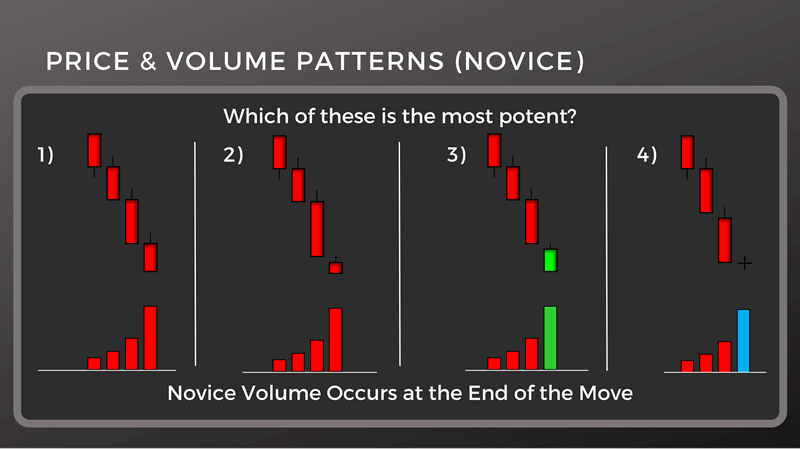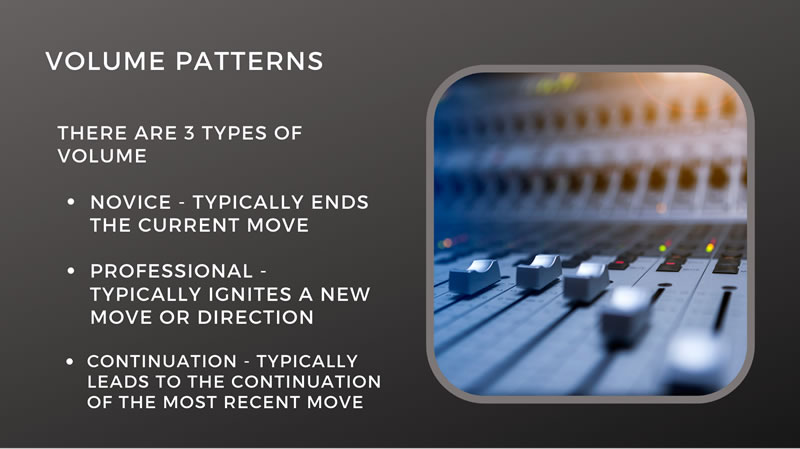Professional traders and investors generally have better access to the market through more sophisticated trading software; unless you use a platform such as DAS, which is on par with professional direct market access. These professional trading platforms allow professional traders to react to market changes faster than retail investors or novice traders. Professional traders work for companies that monitor the markets around the clock, seven days a week. They know that circumstances are changing or might change before it goes into effect. This is why the old maxim “Buy the rumor, sell the news” holds true as professionals try to buy in anticipation of the news release and sell when the actual news is released.
These principles also come into play when reading volume. In previous blogs, we’ve covered the basics of reversal volume patterns. There are three main types of volume. Where the volume occurs in the move tells you what kind of volume it might be. We will outline the different types of volume below.
Types of Volume
- Professional Volume: Usually ignites a move in a new direction. This often occurs in the pre or post market when the most drastic market-changing news occurs.
- Novice Volume: Usually ends the current move. This happens after the professionals have already started pushing the market in one direction or another. The novice traders finally give up on their position, causing a volume spike, right when the move is about to end.
- Continuation Volume: This is the hardest to read of the 3 types of volume. Generally continuation volume is low volume; meaning not much activity happens after a substantial move. e.g. If the stock started to move up and paused, then the volume would start to drop as traders decide whether they want to hold for higher or if they want to take profit. There’s no compelling reason for traders to take profit as the stock is not really going down. The volume is low as a few people take profit and some others join the move expecting higher prices. For this reason, continuation volume tends to be light volume after a substantial move in one direction or the other. We expect the move to continue.
Professional Volume

Above, we see four patterns that indicate professional volume. Stocks are being gapped in one direction or the other but with big volume happening before the open, then getting follow-through volume shortly after. The most potent of these examples is #4 where a Doji is the last bar before the gap down. This is the start of the new move down that is confirmed with stronger than average volume. It is important to note that above average volume is exactly that; it is one volume bar that is significantly larger than the previous bars. In examples #1 and #2 where the stock is going down, pro volume comes in and brings the stock up; that is now the new direction of the stock as confirmed by volume.
Novice Volume

Novice volume is when the volume increases in the current direction of the move but crescendos after a big or prolonged move down. This is sometimes called climactic volume. All four of these patterns are examples of novice volume, regardless of what the final reversal bar looks like. Above, #4 with the Doji is the most powerful reversal pattern.
Continuation Volume

Above are two volume patterns. One shows a clear sign of continuation volume as the first few price candles are up. The volume then drops as shares are being accumulated and some are being sold, but not enough to drive the price down. Once the float is bought up and the stock does not distribute down, the stock is then clear to continue on its path up. The second example shows erratic volume in the base meaning some people are selling their shares while others believe the stock is going higher and buy it with avidity. Ultimately the erratic volume leads to a reversal. This is not an example of continuation volume. As noted above, continuation volume is the hardest type of volume to identify especially in real life markets.
Written by Michael DiGioia, Director of Education
Mike is available for One-on-One Coaching. Learn More





